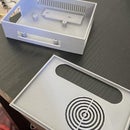Introduction: Ender 3 Pro
Currently, I am enrolled in a class called MAT 594X -- Computational Fabrication. We had to switch to online instruction due to the fears of COVID19, and each student in the class was fortunate enough to receive a 3D printer for class projects. Big thanks to Jennifer Jacobs for providing the device and materials.
I received Creality Ender 3 Pro printer in the mail, and unboxing and assembly were fun! I thought I could share some tips and tricks that I found online for getting the device ready.
Step 1: Assembly
The first thing I did was to separate parts to see if I was missing anything. Once I made sure that everything I need was in the box, I started following the instructions on the assembly sheet. This sheet alone is useful, it goes over everything you need step-by-step. However, there were some problems when I tackled the assembly just with the default instructions.
This video helped me resolve small problems that I encountered. You can find the important points from the video here:
- Make sure the cable coming out of the computer in the base won't get stuck between the vertical bars
- To reduce friction problems later, the vertical bars need to align perfectly.
- The distance between the bars around the base and on the top of the device needs to match.
- They shouldn't be slanted in the x-axis
- Try every part that has wheels on one of the vertical bars, the part needs to slowly roll down under the influence of gravity. If the wheels are too tight, simply adjust the screws in their base.
- Before connecting to the power, make sure to flip voltage control to 115V.
- To insert the material, create a sharp edge at the tip of the material, slide it in the extruder to the tip of the nozzle. If you heat the nozzle before inserting the material, you should be able to see melting material coming out of the nozzle.
Step 2: Testing and Leveling Bed
Once everything is assembled correctly, I used the main knob to navigate to "Prepare/Auto Home". The nozzle moved to its origin point without any problems.
Now I needed to make sure the bed is leveled correctly throughout the surface. I was cautious in this step as the nozzle is fragile. I had to adjust the bed and nozzle in a way that the nozzle barely touches the bed surface. I watched this video to help me determine how close these components need to be.
For leveling, I used the springs underneath the bed and raised the bed until I can slide a regular paper between the nozzle and the bed surface. I repeated this test for all 4 corners, and once more for the center. After the adjustments, I printed a one-layer test pattern and realized left corners were still too low. I adjusted them again and it was ready to print!
Step 3: Improve Printer
To test with a real object, I wanted to improve the printer itself with custom made components. There is a big community out there who designs detailed parts for these purposes. I found this cable chain online, and I thought that it could be a good addition to the printer since the power cables looked too exposed. I downloaded the model, placed some of its components in Cura software to see how long it takes. It turns out printing the whole thing takes ~20 hours and uses more material than I currently have (I couldn't find exactly how much sample material came with the box, but a simple kitchen scale showed around 60grams after my initial bed leveling test). I decided to print a subset of components and laid 15 of the joints on a plane. I set up the nozzle temperature to 205, and bed to 60 degrees. 6-6.5 hours later I had the cable chain ready. Simply rolling the bed cover around a table edge loosened all the parts and they didn't leave any marks. The parts feel fragile but they do latch onto themselves strongly.













